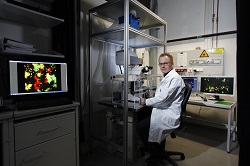Genetic tracking provides clues on the development of the brain’s complex circuitry
The brain is made up of billions of cells of different types organised into sophisticated networks which determine the functions of the brain. EU-funded scientists from the MOMECODE project are using novel ways of marking particular cells to understand how the nerve cells or neurons develop and interconnect during brain development. The scientists use genetic markers to colour-code and track the neurons’ path as they find their rightful place in a particular brain area, the developing cerebral cortex. “When a neuron is born from a neural stem cell, usually it migrates some distance to the specific area where the cells wire up into so-called circuits,” says Simon Hippenmeyer, assistant professor at the Institute of Science and Technology, Austria, where he set up a laboratory after returning from Stanford University, United States, re-establishing himself in Europe with an EU Marie Curie grant. A genetic technique called Mosaic Analysis with Double Markers (MADM), allows researchers to visualise small groups of neurons or even individual neurons at the single cell level and genetically manipulate them at the same time, Dr Hippenmeyer explains. Comparing red and green-marked cells The technique helps researchers navigate through dense networks and precisely follow individual neurons. Red and green fluorescent protein markers are encoded in the mouse genome to label certain types of neurons, and a genetic mutation can be introduced. The two healthy neurons in one colour and sick neurons in the other are then compared to understand how the cells behave in healthy and diseased conditions. “The MADM technique allows us to do this at highest resolution, so we can do certain types of quantitative analysis that were not previously possible,” Dr Hippenmeyer says. Tagging a cell while also introducing a genetic modification into that cell is technically challenging. “There is no other comparable technique that allows us to do this easily at the high precision level that MADM can,” says Dr Hippenmeyer, explaining that researchers usually need to compare two different animals, one that is sick and one that is healthy, rather than seeing the cells side by side in a ‘mosaic’. Fixed neuron output The ability to count single cells led to the discovery that there is a clear period of neuron fabrication during brain development. “There is a fixed output of about 8–9 neurons per single neural stem cell, which is always uniform,” Dr Hippenmeyer says. “This discovery was unexpected because most stem cells in different organs reproduce at an unpredictable rate.” Stem cells must perfectly tune their output otherwise there are too many or too little — leading to a brain that is either too large or too small — and there is a lot of genetic influence on this process, he says. “We are trying to understand the natural mechanisms in the stem cells that give rise to a brain of the correct size.” Although the MOMECODE experiments are conducted in laboratory mice, eventually this could also shed light on human brain development and perhaps evolution. Many psychiatric disorders may be caused by subtle changes in brain architecture. The cell-highlighting technique can be replicated using candidate genes that may be disrupted in psychiatric diseases or dementia to see how these changes affect the brain. Such approaches may shed light on the basis of neurodevelopmental diseases and help to understand why human brain development is so sensitive.
Keywords
MOMECODE, brain, brain development, neurons, cognition, behaviour, fluorophores, biomarker, stem cells, psychiatry







